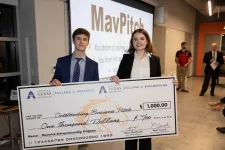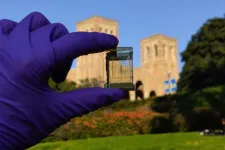(Press-News.org) University of North Carolina at Chapel Hill researchers have discovered that tardigrades – microscopic animals famed for surviving harsh extremes – have an unusual response to radiation.
Led by UNC-Chapel Hill researcher Bob Goldstein’s lab, the new research paper published on April 12 in Current Biology reveals new details on tardigrades’ responses to radiation. Radiation has long been known to damage DNA, and in humans, DNA damage from excessive radiation exposure can lead to diseases. But the tardigrades have an unexpected way to correct the damage.
“What we saw surprised us,” said Goldstein. “The tardigrades are doing something we hadn’t expected.”
Goldstein’s lab has developed lab methods for studying tardigrades for the past 25 years. The lab has identified several tricks that tardigrades have for surviving conditions that would be life-threatening for humans and most animals.
Sixty years ago, researchers discovered that tardigrades could survive about 1000 times more intense radiation than humans are known to survive. Courtney Clark-Hachtel, a former postdoctoral scholar in the lab joined the group to examine how tardigrades can survive intense radiation. She found that a species of tardigrade is not immune to DNA damage – irradiation does damage their DNA – but the tardigrades can repair extensive damage.
Clark-Hachtel and Goldstein were surprised to find that tardigrades can increase the volume of production from DNA repair genes. Unlike humans, tardigrades can ramp up the level of DNA repair genes’ products to such an extreme extent that they become some of the most abundant gene products in animals.
“These animals are mounting an incredible response to radiation, and that seems to be a secret to their extreme survival abilities,” said Clark-Hachtel. “What we are learning about how tardigrades overcome radiation stress can lead to new ideas about how we might try to protect other animals and microorganisms from damaging radiation.”
As the UNC-Chapel Hill scientists completed the work, researchers in France found similar results in independent experiments. Museum of Natural History Paris researchers Jean-Paul Concordet and Anne de Cian and their coworkers also found a new tardigrade protein that could protect DNA. Their results are reported in the journal eLife.
“We were thrilled to see that each lab’s results could independently confirm each other,” Goldstein adds.
END
UNC-Chapel Hill researchers discover new clues to how tardigrades can survive intense radiation
Discovery reveals that tardigrades have an unusual response to radiation
2024-04-15
ELSE PRESS RELEASES FROM THIS DATE:
UT Arlington prioritizes entrepreneurship efforts
2024-04-15
Universities are engines for economic growth that today are supporting technology development, innovation and economic advancement as never before.
With the launch of its Center for Entrepreneurship and Technology Development (CETD), The University of Texas at Arlington is beginning a new era of support for student and faculty entrepreneurship. The center, whose mandate also includes supporting the region’s vibrant innovation economy, will expand UTA’s engagement with public and private partners everywhere.
“CETD fosters a vibrant and supportive atmosphere ...
Ochsner Health receives 2024 Top Workplaces Culture Excellence Awards
2024-04-15
NEW ORLEANS, La – Ochsner Health is the recipient of the 2024 Top Workplaces Culture Excellence awards in four distinguished categories: Innovation, Work-Life Flexibility, Leadership and Purposes & Values. These accolades are administered by Energage, a purpose-driven organization that develops solutions to build and brand Top Workplaces.
The Top Workplaces program has a 17-year history of surveying and celebrating people-first organizations nationally and across 60 regional markets. Top Workplaces awards are based on feedback from a research-backed employee engagement survey.
“It is an honor to receive ...
Are these newly found rare cells a missing link in color perception?
2024-04-15
Scientists have long wondered how the eye’s three cone photoreceptor types work together to allow humans to perceive color. In a new study in the Journal of Neuroscience, researchers at the University of Rochester used adaptive optics to identify rare retinal ganglion cells (RGCs) that could help fill in the gaps in existing theories of color perception.
The retina has three types of cones to detect color that are sensitive to either short, medium, or long wavelengths of light. Retinal ganglion cells transmit input from these cones to the central nervous system.
In the 1980s, David Williams, the William G. Allyn Professor of Medical Optics, ...
Annals supplement highlights important new evidence readers ‘may have missed’ in 2023
2024-04-15
Embargoed for release until 5:00 p.m. ET on Monday 15 April 2024
Annals of Internal Medicine Tip Sheet
@Annalsofim
Below please find summaries of new articles that will be published in the next issue of Annals of Internal Medicine. The summaries are not intended to substitute for the full articles as a source of information. This information is under strict embargo and by taking it into possession, media representatives are committing to the terms of the embargo not only on their own behalf, but also on behalf ...
NIH awards $2.3 million grant to University of Oklahoma for gene therapy research
2024-04-15
NORMAN, OKLA. – University of Oklahoma engineering researcher Sangpil Yoon, Ph.D., has been awarded a $2.3 million grant from the U.S. Department of Health and Human Services, National Institutes of Health, for his project titled “Development of protein-based nanostructures activated by ultrasound.”
The five-year grant is part of the NIH’s Research Project Grant (R01) program, which supports cutting-edge health-related research and development initiatives. Yoon’s funding, totaling $363,919 for ...
Hidden threat: Global underground infrastructure vulnerable to sea-level rise
2024-04-15
As sea levels rise, coastal groundwater is lifted closer to the ground surface while also becoming saltier and more corrosive. A recent study by earth scientists at the University of Hawai‘i (UH) at Mānoa compiled research from experts worldwide showing that in cities where there are complex networks of buried and partially buried infrastructure, interaction with this shallower and saltier groundwater exacerbates corrosion and failure of critical systems such as sewer lines, roadways, and building foundations.
“While it has been recognized that shallowing groundwater will eventually result in chronic flooding as it surfaces, ...
Study reveals AI enhances physician-patient communication
2024-04-15
As one of the first health systems in the country to pilot the use of generative artificial intelligence (GenAI) to draft replies to patient messages inside the Epic Systems electronic health record, UC San Diego Health is a pioneer in shaping the future of digital health.
The results of a new University of California San Diego School of Medicine study indicate that, although AI-generated replies did not reduce physician response time, they have contributed to relieving cognitive burden by starting an empathetic draft, which physicians can edit rather than starting from scratch.
The study, published in the April 15, 2024 online edition of the Journal of ...
Mitchell A. Lazar honored with prestigious George M. Kober Medal for pioneering contributions to diabetes and metabolic research
2024-04-15
PHILADELPHIA— Mitchell A. Lazar, M.D., Ph.D., the Rhoda and Willard Ware Professor in Diabetes and Metabolic Disease, and Director of the Institute for Diabetes, Obesity, and Metabolism in the Perelman School of Medicine at the University of Pennsylvania, is the 2025 recipient of the George M. Kober Medal from the Association of American Physicians (AAP). Lazar will receive the honor in Chicago at the AAP’s annual meeting which takes place April 25-27, 2025.
The AAP, an elected society of the nation’s most distinguished physician scientists, was founded in 1885 by seven physicians, including Sir William ...
SMU prof to use NSF grant to develop game-based semiconductor curriculum for high school students
2024-04-15
DALLAS (SMU) – The challenge is to connect the dots for high school students between the technology in their cell phones and the career options manufacturing the devices. To that end, the National Science Foundation (NSF) has awarded an Innovative Technology Experiences for Students and Teachers (ITEST) grant to SMU professor Lin Lipsmeyer and colleagues toward developing one of the first game-based semiconductor curricula for high school students.
The online game-based semiconductor curriculum will be made available to a wide range of students through a collaboration with Dallas-based gaming company Stimuli. Additional ...
Advance in light-based computing shows capabilities for future smart cameras
2024-04-15
Researchers developing the next generation of computing technology aim to bring some light to the field — literally.
Optical computing, which relies on particles of light called photons, is expected to provide alternatives to traditional electronic approaches. Such systems — or light-based components of hybrid systems that also retain electronic parts — could be faster, consume less energy and compute visual information more efficiently through simultaneous, parallel processing.
To date, ...
LAST 30 PRESS RELEASES:
Artificial saliva containing sugarcane protein helps protect the teeth of patients with head and neck cancer
Understanding the role of linear ubiquitination in T-tubule biogenesis
Researchers identify urban atmosphere as primary reservoir of microplastics
World’s oldest arrow poison – 60,000-year-old traces reveal early advanced hunting techniques
Bristol scientists discover early sponges were soft
New study uncovers how rice viruses manipulate plant defenses to protect insect vectors
NSF–DOE Vera C. Rubin Observatory spots record-breaking asteroid in pre-survey observations
Ribosomal engineering creates “super-probiotic” bacteria
This self-powered eye tracker harnesses energy from blinking and is as comfortable as everyday glasses
Adverse prenatal exposures linked to higher rates of mental health issues, brain changes in adolescents
Restoring mitochondria shows promise for treating chronic nerve pain
Nature study identifies a molecular switch that controls transitions between single-celled and multicellular forms
USU chemists' CRISPR discovery could lead to single diagnostic test for COVID, flu, RSV
Early hominins from Morocco reveal an African lineage near the root of Homo sapiens
Small chimps, big risks: What chimps show us about our own behavior
We finally know how the most common types of planets are created
Thirty-year risk of cardiovascular disease among healthy women according to clinical thresholds of lipoprotein(a)
Yoga for opioid withdrawal and autonomic regulation
Gene therapy ‘switch’ may offer non-addictive pain relief
Study shows your genes determine how fast your DNA mutates with age
Common brain parasite can infect your immune cells. Here's why that's probably OK
International experts connect infections and aging through cellular senescence
An AI–DFT integrated framework accelerates materials discovery and design
Twist to reshape, shift to transform: Bilayer structure enables multifunctional imaging
CUNY Graduate Center and its academic partners awarded more than $1M by Google.org to advance statewide AI education through the Empire AI consortium
Mount Sinai Health system receives $8.5 million NIH grant renewal to advance research on long-term outcomes in children with congenital heart disease
Researchers develop treatment for advanced prostate cancer that could eliminate severe side effects
Keck Medicine of USC names Christian Pass chief financial officer
Inflatable fabric robotic arm picks apples
MD Anderson and SOPHiA GENETICS announce strategic collaboration to accelerate AI-driven precision oncology
[Press-News.org] UNC-Chapel Hill researchers discover new clues to how tardigrades can survive intense radiationDiscovery reveals that tardigrades have an unusual response to radiation



